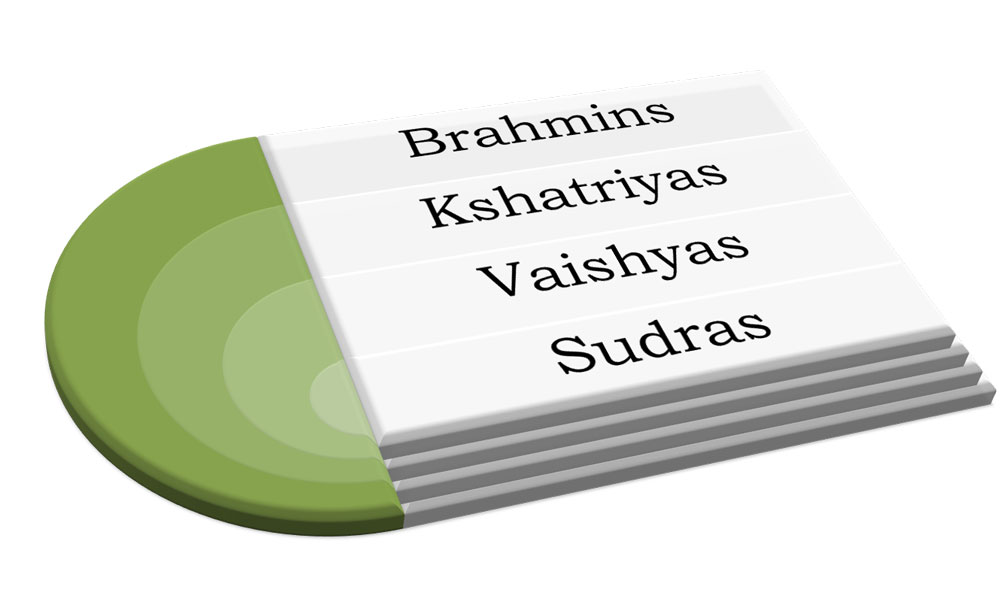In Hinduism, Varna is known as Category (it’s not caste) which was divided in four parts in ancient time named as Brahmins, Kshatriyas, Vaishyas, and Shudras.

Evolution of Varna System
In ancient time when men lived in caves and hunted animals for his survival, there was only one profession, viz., to hunt and provide food to the family. In addition, they were also providing protection to old, ladies and children.
As man evolved from caveman to a man of agriculture, human habits developed in the form of villages. This resulted in the formation of multi-professional society and various classes of professions like, producing, marketing, education, maintenance of infrastructure, protection society from invaders, etc. This required proper and just division of labor so as to have a harmonious and peaceful co-existence among different groups of people.
According to social psychologists, each individual is mentally and physically designed to a certain kind of profession and this understanding lead to the evolution of social class system in ancient India. It was considered as Dharma to conform to the rules and practices laid for each social class called Varna.
Four Varna System
The four Varnas are as follows,
- Brahmins: Those people who were found to be mentally active, were assigned the task of learning, and then impart knowledge and skills to the children in the village. Additionally, they also gave spiritual knowledge to their pupils, so that they may live ethical and peaceful life. These teachers were called Gurus. They opened schools, known as Gurukuls. The Gurukuls were residential. The students left their homes and lived in the natural surroundings and did all their work themselves. They learnt dignity of labour, equality of all human beings and control over their physical desires. These students evolve themselves as overall balanced human beings. The Gurukuls were supported by donations from the society. Also, their was a practice of offering Guru Dakshinas to Gurus by the students at the end of their stay in Gurukul. Gurudakshina was decided by the Guru according to capacity of the student.
- Kshatriyas: Those people who were strong and brave were grouped under social class named Kshatriya. Their main profession was to protect the society from outside aggression and to maintain law and order in the society. The Kings, his family members and his courtiers belonged to this cadre. In Gurukul, this class of people, right from childhood, were taught archery and other skills of war.
- Vaishyas: Since goods were produced, there came a need to have a social class which can market the goods to the society. They also lent money to needy people. This class of people were called Vaishya. Even today, some class of people in Vaishya community continue their age-old profession of trading.
- Shudras: Some people by their very in-born nature were are not capable of doing the above mentioned three classes of professions and therefore they were trained in the regular upkeep of infrastructure and low grade trading professions like pottery, leather work etc.
It was the Swadharma of the individual to follow profession of their respective class. Initially, these social classes were based on the nature of the person and were not based on their origin of birth. Even a person of Vaishya community would become Kshatriya and vice-versa. But, over the periods, the Varna system was restricted to the social class in which a person was born. This restricted their growth potential. However, with the passage of time, this restriction has gone.
These days, an individual, irrespective of social class free to get him self educated and choose any profession.
Advantages of Varna System
- It brings in organization. This brings in harmony.
- Trade practices were passed on from generation generation, leading to more proficiency in the profession.
- Within a Varna, people develop a common code conduct, social practices, values and beliefs. This results in minimal conflicts.
Disadvantages of Varna System
Though the Varna system was designed for a good cause but it lost its true value when was maligned by Mughals and Britishers era by information wars. So these disadvantages are only after maligned history.
The disadvantages of Varna system are as follows:
- It did not allow an individual to exploit his potential. Shudra was not allowed to do any other profession except the professions designed for them.
- It created a class conflict. Shudras were treated badly. They were not allowed to be a part of the society. They were not allowed to take water from the common well. They, also could not enter a temple.
This is how, the Varna System were existed in Hinduism in ancient India.

